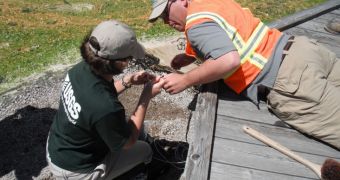Throughout the summer of 2010, experts have installed a sensor network inside Yellowstone National Park, which is meant to give them the ability to keep an eye on what is going on inside the area, temperature-wise, nearly in real-time.
In addition to being a beautiful area, and home to numerous species, Yellowstone is also one of the most active geyser basins in the United States. As such, keeping an eye on what goes on here is very important.
The sensor network is meant to do just that. It is operated by the US Geological Survey (USGS), which announces that it has already began receiving the first results from the Norris Geyser Basin, earlier this month.
Throughout the area, USGS experts mounted 10 radio-equipped sensors, which are capable of recording temperatures in runoff channels from geysers, hot pools, soils, and even air.
The data collected by the sensors is not transmitted to the command center instantly, but rather on a daily basis. This is done through the use of small radios and the Internet.
The USGS offices that coordinate the research are located in Menlo Park, California. Here, researchers archive, plot and distribute the maps to the general public, via the Yellowstone Volcano Observatory website.
Being able to assess changing conditions over such narrow time frames will be of great value to researchers seeking to rapidly determined changes in climate and temperatures.
“This innovative use of new technology will allow the public, park staff, educators, and scientists to observe temperature variations in Norris Geyser Basin, one of Yellowstone’s more dynamic geyser basins,” explains YNP geologist Henry Heasler.
“We’ve tried to make the system as robust as possible,” says YVO principal scientist Jake Lowenstern.
“If an antenna fails, the loggers should be able to keep recording and hold on to their data for about a month, and then send all their information once we get out to fix the equipment,” he adds.
A possible application for the network will be that Park officials will be able to monitor thermal features for educational and safety purposes.
Another one is that seismologists may keep an eye on seismic tremors, by gagging temperature changes in local streams
Working together with the USGS on this endeavor are experts from the University of Utah and the Yellowstone National Park.

 14 DAY TRIAL //
14 DAY TRIAL //